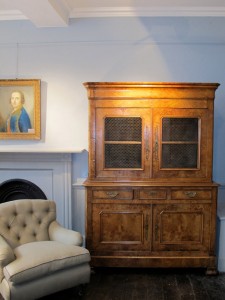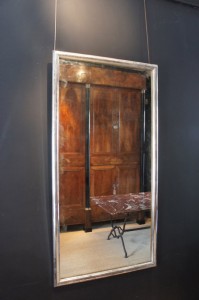Morphy’s Sept. 21 Doll Auction features prized antique French bisques, German characters and 20th-century favorites
August 27th, 2013 by adminDENVER, Pa. – A fine selection of German bisque dolls and a parade of French bisque beauties – including a circle dot Bru – will join Schoenhuts, Googlies and other 20th-century classics at Morphy’s September 21 Doll Auction.

Morphy’s Doll Auction – 9.21.13
The 623-lot sale consists of consignments from a number of discriminating doll enthusiasts, with the largest single grouping coming from a well-refined, long-time Pennsylvania collection.
Premium-quality French bisque dolls encompass quite a wide production range, from fashion dolls to boxed DEPs and productions by Jumeau, Steiner and SFJB. The top-estimated doll of the sale is Lot 262, a Bru circle dot bébé with chubby cheeks and deep brown paperweight eyes with amber threading. The Bru is expected to make $15,000-$25,000.
Morphy’s doll specialist Jan Foulke explained that collectors are always on the lookout for late-19th-century bisques like the Bru circle dot bébé in the upcoming auction because they represent the golden age of French doll manufacture. “Dolls made in France around the 1870s and 1880s were exquisite productions,” Foulke said. “No other dolls can match them for their beauty and quality.”
Another French bisque highlight is Lot 130, a very rare circa-1877 mignonette doll with ball joints in both elbows. “Mignonette means ‘sweet little thing.’ It’s a term the French doll makers used in their catalogs to describe this type of small, very appealing doll,” said Foulke. “The doll to be auctioned is only 5-1/2 inches tall and is extremely desirable because it’s as original as the day it left the factory.” Its presale estimate is $2,500-$3,500.
The German bisque character category is brimming with fine Hertel, Schwab & Co., Heubach, Kley & Hahn, and Kammer & Reinhardt dolls. The varied lineup includes child, lady, nurse, Santa and “pouty” dolls. Lot 289, a rare and impressive glass-eyed 21in K&R 114 doll in antique pink cotton dress with matching hat, displays crisp modeling and an especially pouty mouth. Estimate: $7,000-$9,000.
Lot 163, a rare 16in Heubach 7746 character doll is ready to entertain in an antique gold and black ruffle-neck clown suit, pointy red hat with white polka dots, and black buckle-front shoes. His cheeky grin reveals well-molded lower teeth. The doll could make $3,000-$5,000 at Morphy’s.
Ever-popular Googlies will cross the auction block, with the top entry being Lot 19, a saucy Hertel, Schwab & Co. 172 estimated at $3,000-$5,000. Another Googly prize is Lot 436, an A.M. 323 boy doll dressed in a colorful, factory-original lederhosen outfit with all accessories, including tie, hat, wool stockings and leather shoes. A good size at 12 inches, the smartly outfitted fellow is expected to reach a bid of $1,500-$2,500.
Other early productions that collectors are sure to find appealing include turn of the 20th century Chinese Door of Hope dolls (Lot 202, Amah nursemaid with baby, est. $1,200-$1,800), French wax fashion ladies, and black dolls. Philadelphia-made Schoenhuts are led by Lot 338, a 15in all-wood “Miss Dolly” that was introduced to the market in 1915. The example to be auctioned is all original and dressed in its white factory chemise with pink stockings and pink leather shoes. It also retains its original box with graphics of Schoenhut dolls, information about Miss Dolly’s metal joints, and an explanation of how the doll was made. The auction estimate is $1,000-$1,500.
Composition dolls include Shirley Temple, Sonja Henie, the Dionne Quintuplets, a Dewees Cochran boy, Vogue Toddles and many more. Mid-century dolls are abundant in the Sept. 21 sale, as well, with an array of Madame Alexander Cissy dolls, hard plastic Ginnys, Hoyers, boxed Tonis and several other popular types. A quality grouping of Barbies includes a #2, #4, #5, and an excellent Blonde Ponytail #1 Barbie in striped one-piece swimsuit and original box, estimated at $2,000-$3,000.
There’s much more to attract collectors’ attention on auction day, including cloth and Swiss wood dolls, artist dolls (Sashas, R. John Wright, etc.), teddy bears, a grouping of 19th-century Neapolitan crèche figures, and a varied selection of doll clothes, accessories and furniture.
“Over the past several years we’ve seen a disparity in auction prices – up, then down, then up again on the same model of doll – and in every case it was the originality and condition of the doll that determined what it sold for,” said Foulke. “I think the September 21st auction is going to please collectors who want fresh, original dolls in excellent condition.”
Morphy’s September 21 Doll Auction will commence at 9 a.m. Eastern Time. All dolls are available to preview 7 days a week during regular business hours (9 a.m. to 4 p.m.) at Morphy’s gallery; or on auction day from 8-9 a.m.
**All forms of bidding will be available, including live via the Internet through Morphy Live, LiveAuctioneers or Artfact. View the fully illustrated catalog online at www.morphyauctions.com, www.liveauctioneers.com or www.artfact.com. For additional information, call 717-335-3435 or e-mail serena@morphyauctions.com. Visit Morphy’s online at www.morphyauctions.com.


